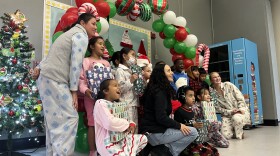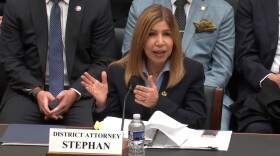From molecular cuisine to super-sizing, the fads, techniques and marketing of restaurants have long been a mainstay of both high and popular culture. Now a unique laboratory in the Netherlands is closely monitoring people as they chow down.
It's called, a little ominously, the Restaurant of the Future.
It looks like any trendy, healthy-food cafeteria: soft lights, floor-to-ceiling windows, salad buffets, an enormous soup pot. Then you glance up at the ceiling and see small maroon domes.
They're cameras.
The Restaurant of the Future is co-owned by Wageningen University, Holland's preeminent agriculture and life-sciences university. To eat here, you have to fill out a questionnaire and sign a research waiver.
"This is a living laboratory," says Rene Koster, co-founder and manager of the restaurant. "Every day we could have a project ongoing. And the people that come here are not aware if there's a project ongoing or not, basically because they don't see it. On one hand, it's a normal restaurant run by professionals where people come and have an enjoyable meal and there could be research ongoing, but you don't feel it, you don't smell it, you don't taste it."
A black rubber scale at one of the cash registers unobtrusively weighs diners. All of their choices are recorded. Afterward, the staff weighs how much of each food is thrown away to find out how much people are actually eating. They also monitor how light, color, sound, presentation and eating alone or in groups affects diners' choices.
Big Brother
A few steps down the hall from the restaurant, through thick gray doors, is one of two monitoring centers. They're dominated by computer screens fed by those maroon video eyes inside the restaurant.
"This is what we call Big Brother Room One," says Koster. "Only the scientists are allowed to come in, and they control the video cameras."
Joysticks enable them to survey every inch of the restaurant — noting everything from how long diners take to make a choice to their facial expressions while eating. Then the scientists turn those images into data.
Among other things, their research shows that everyone eats lighter on Monday than on Friday; women take five times as long to choose their meals as men; and, perhaps not too surprising, men and women choose differently depending upon who else is at their table.
"If women eat with other women," says Koster, "they tend to indulge, more than if men were present. Then, women tend to take out more, let's say, the healthy foods. And that's simply basic human behavior. You want to show off. That's all, more or less, say, subconsciously a way of expressing yourself to others."
When men are together, they compete to see who can wolf down the most.
Restaurants And Science
Restaurants have always been linked both to science and the need to be seen, says Indiana University historian Rebecca Spang, who's written about the birth of restaurants in 18th century France in her book, The Invention of the Restaurant: Paris and Modern Gastronomic Culture.
"The first restaurants emerge also in the context of a particular kind of science — not 21st century food science, but 18th century science of sensibility," Spang says. "And what a restaurant is, is a place that one goes not to be nourished, because that's vulgar, but to be restored."
The Restaurant of the Future itself may resemble most any pleasant "restorative" eatery, but most of the hard research takes place in near-clinical tasting labs — where outsiders are never invited. In one, participants sit on what looks like a large salon chair and are fitted with tubes to the mouth and the nose. A recent project targeted low-fat milk using a "gustometer" for taste and an "olfactometer" for aroma.
"So the gustometer device injected the low-fat milk into the mouth. On top of that, we presented a cream aroma in the nose," says Rene Dewijk, a psychologist who directed the project.
Guess what? Not only did the subjects say the low-fat milk tasted like whole milk, but they even said it had the texture of whole milk.
That milk test was undertaken for the dairy industry and has already changed how milk and low-fat dairy products are produced. Much of the work at the Restaurant of the Future is on contract to private industry. In fact, Wageningen University's key partner and sponsor is Sodexho, the world's second-largest food preparation company. And that distresses Spang — at least somewhat.
"This is the kind of neuro-economic consumer psychology research that drives all of us, shall I say, old-fashioned humanists really a bit mad," Spang says. "And because it costs more, everybody assumes it's more valuable than, oh, paying me $50,000 a year to go off to the library and read some things."
Spang calls it capitalism run wild. But the researchers at the Restaurant of the Future point out that their work also contributes to more effective strategies for fighting obesity and making healthier, low-calorie food taste better.
Copyright 2022 NPR. To see more, visit https://www.npr.org. 9(MDAzMjM2NDYzMDEyMzc1Njk5NjAxNzY3OQ001))






